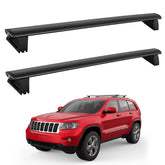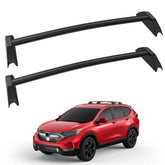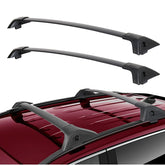Different Types of Roof Racks
Thanks to roof racks, you can install several types of carrying accessories on your vehicle: bike racks, roof boxes, ski racks, etc. Find out more in this article!
Longitudinal racks: aesthetic and functional
Longitudinal roof racks run from the front to the rear of the vehicle and are very common on premium cars. That's why they're also known as roof rails or side racks. In addition to giving the car a stylish look, longitudinal rails can also be used as a platform for transverse roof racks. They attach to the sides of the roof and can be used as a support for cross roof racks. Generally, there are two types of roof bars:
- Open roof racks.
- Integrated (or closed) roof racks.
On a vehicle equipped with open roof racks, there's a gap of just a few centimeters between the roof and the bars. Integrated racks, on the other hand, can be installed without leaving a gap with the roof.

Roof rack crossbars: essential for carrying equipment
Crossbars are mounted perpendicular to the roof. The mounting system generally depends on the roof structure:
- Normal roof.
- Roof with anchor points.
- Roof with T-slots.
- Roof with gutters.
- Roof with open side rails.
- Roof with integrated side rails.
Differences between cross bars and longitudinal bars
The main difference between cross bars and longitudinal bars is the installation position. Unlike longitudinal bars, crossbars are installed perpendicular to the installation position of longitudinal bars.
Cross bars are essential for carrying devices such as roof-mounted bike racks, kayak racks, roof boxes, snowboard racks, surfboard racks, etc.
Cross bars are versatile and can be used for several models with similar features. However, the mounting system for each set of bars is designed according to the structure and shape of the roof (normal roof, with gutters, anchor points, integrated longitudinal bars, open longitudinal bars, T-slots...).
OEMs generally offer two types of roof racks: steel and aluminum.

Steel roof racks
Steel roof racks are very cost effective. They are strong, durable and very convenient. They are usually made of galvanized steel and covered with a black or gray PVC anti-corrosion coating.
The main advantage of steel roof racks is their load-bearing capacity, which is generally higher than that of aluminum bars. However, steel bars are heavier and less aerodynamic. As a result, they are noisier and have a greater impact on fuel consumption.
Aluminum cross bars
With their modern, sleek design, aluminum roof racks offer many advantages over steel racks. They are lighter, more aesthetically pleasing and more aerodynamic.
Premium roof racks feature a low profile that blends in perfectly with the vehicle's roofline. They are installed close to the roof and are therefore very discreet. Their more aerodynamic shape and lighter weight help reduce noise and fuel consumption. They are less noisy and have a good load-bearing capacity, allowing the installation of several types of carrying equipment: roof-mounted bicycle rack, ski and snowboard rack, roof box, surfboard rack, etc.
The only disadvantage of aluminum roof racks is their relatively higher price!
Featured Products
- $83.99
- $83.99
- Unit price
- / per
- $85.99
$138.90- $85.99
- Unit price
- / per
- $69.99
- $69.99
- Unit price
- / per
- $98.99
- $98.99
- Unit price
- / per














